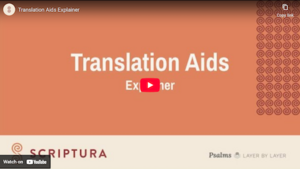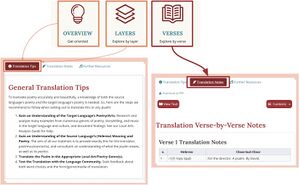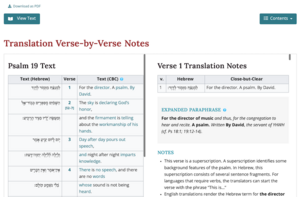Users Guide: Translation
User's Guide Contents
Translation Aids
Welcome to the User’s Guide for our Translation Aids. This page is written by translation experts, including Translation Consultants, and it reframes all of our resources to meet the specific needs of translators and performers, for both written, oral, or song translation. The purpose of these resources is to assist in the drafting and checking of Bible translations and artistic renditions.
The page is split into two main tabs:
- Translation Tips: Key information about the psalm as a whole which might be helpful for translators and performers.
- Translation Notes: Verse by verse walk through giving essential information for translators and performers.
These two pages (Tips and Notes) relate to the rest of our layer-by-layer resources in different ways. See each tab below for more details.
Translation Tips (Whole Psalm)
As the arrows in the image to the right show, the resources for the Translation Tips are taken mostly from our Layer by Layer resources as well as the psalm Overview page. This page is made up of 7 tabs covering key information which any translator should keep in mind for this psalm. In translation, verse by verse accuracy is important, but it is just as important to create a translation that is faithful to the psalm as whole. In each tab we reorganize the resources from our layers and overview page into brief presentations. If users wish to explore any of the materials in more depth, links are provided to the corresponding pages in the rest of our resources.
The first tab is our Overview, bringing the most important points from our psalm Overview page.
The second tab is the Background, providing key background information taken from our Story Behind layer.
The third tab is the Layout, which presents the at-a-glance structure visual, which is taken from the structure section of the psalm Overview page.
The fourth tab is Emotions, which presents that same structure as in the Layout tab, but with just the main emotions in view for each section. The content here is taken from our Emotional Analysis.
The fifth tab is Participants and Speech Act, which presents our speech act summary visual, which also keeps in view the speaker and addressee for each verse. The content here relates to our Participant Analysis and Speech Act layers.
The sixth tab is Poetry, which presents any key poetic features useful for translator and performers. This will often be just one or two of the poetic features, and users are invited to visit the full Poetic Structure and Poetic Features layers for more.
The final tab is the Prominence tab, which presents the finding from our Prominence analysis, highlighting the most important and climactic moments within the psalm. For musical translations, this analysis is especially helpful for creating refrains or choruses.
Translation Notes (Verse by Verse)
As the arrows to the right show, the resources for the Translation Notes correspond closely with our Verse by Verse page. This page corresponds closely with our verse by verse notes page. However, here we focus on the content most relevant for translators and performers. Many technical points are left out, and translation points are added, interacting also with modern Bible translations in other languages of wider communication, like French, Spanish, and Hausa.
On this page you can press “View Text” to open and close the text. The notes are on the right. In the text view you can also press any verse to jump to the notes for that verse, and press any words in blue to jump to the notes for those words. For a walkthrough of the similarities and differences between the Translation Notes and the Verse by Verse notes, see the Explainer Video above.



